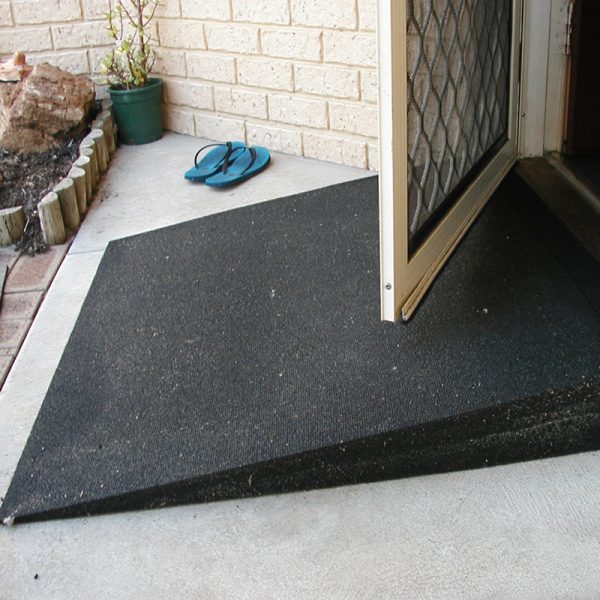
Whether in a home, workplace, healthcare facility or community setting, ramps help users move safely over steps, thresholds and uneven surfaces. We proudly supply Tyrex rubber access ramps, Australian-made solutions known for their durability, slip resistance and long-term performance. Produced in Cardiff, NSW, Tyrex ramps are engineered to provide reliable mobility support across residential, commercial and industrial environments.
Tyrex is recognised nationwide for its commitment to quality, sustainability and accessibility. Many products are made from recycled Australian rubber and manufactured in a carbon-neutral facility, supporting both durability and environmental responsibility. With decades of industry experience, Tyrex works closely with OTs, builders, healthcare providers and retailers to deliver practical, long-lasting access solutions. In this article, we chat with Troy Turner, Tyrex’s Operations Manager, to gather his insights on choosing and measuring the right access ramp. Whether standard or custom-made, Tyrex ramps are trusted for their precision, strength and ability to improve mobility in everyday settings.
Access ramps are essential across a wide range of environments, helping people move safely and confidently over steps, thresholds and uneven surfaces. You’ll find them commonly installed in:
According to Troy, ramps play a bigger role than most people realise. “A well-fitted ramp doesn’t just improve access—it increases independence. It allows people to enter a room, a home or a business with dignity and without assistance. That’s what good accessibility should achieve.”
Ramps help improve independence, accessibility and overall safety for wheelchair users, mobility device users, and anyone with reduced mobility.
Tyrex’s rubber access ramps are engineered for performance and longevity, made from high-quality, Australian-recycled rubber. They are:
Troy explains, “Rubber is incredibly versatile. It absorbs impact, stays stable under load, and gives you traction where you need it most. It’s also far more forgiving than steel or aluminium, especially in clinical and residential environments.”
Explore our full range of Tyrex Rubber Ramps here: Tyrex Ramps Archives - AC MOBILITY
Used for doorways, steps and general level changes. Ideal for wheelchairs, walkers and everyday foot traffic.
Troy’s note: “These are the workhorse ramps—simple, strong and adaptable to most situations.”
Perfect for small rises, sliding door tracks and uneven flooring.
Troy adds, “Even a 20mm lip can be a major trip hazard. Wedges eliminate that immediately.”
Purpose-built for bathrooms, wet rooms and clinical settings.
Troy explains: “These are designed not just for access, but to manage water flow. Getting both right is critical in healthcare environments.”
Lightweight and compact, ideal for on-the-go mobility.
Troy comments: “Portability is key for users travelling with their mobility equipment—these ramps offer convenience without compromising safety.”
Made to measure for unique openings, complex rises or specific clinical requirements.
Troy notes: “No two buildings are the same. Custom ramps are often the difference between acceptable access and perfect access.”
Accurate measuring ensures a safe, comfortable ramp fit. Troy emphasises, “Getting the measurements right is the foundation of good accessibility. One or two millimetres out can completely change the gradient or stability.”
Use this 3-step method:
Measure the rise from ground level to the top of the threshold.
Record both:
Measure from back to front to determine the gradient and user comfort.
Measure the full width of the doorway or opening from left to right.
Some ramps need angled side wings to create a seamless transition.
Always measure in millimetres.
As Troy says, “Precision matters. These measurements dictate the ramp’s performance.”
A custom ramp is ideal when:
Troy explains: “Custom ramps solve the problems that off-the-shelf ramps can’t. They’re tailored to the space, the user and the exact requirements.”
Request a custom quote here: Tyrex Ramps Archives - AC MOBILITY
When selecting an access ramp, consider:
Troy sums it up well: “The right ramp is the one that makes movement effortless. When a ramp is fitted properly, it shouldn’t draw attention—it should just work.”
If you’re unsure which ramp suits your needs, our team is here to help. We can guide you through measurements, ramp selection and compatibility, with expert insight from Tyrex’s leading access solutions team.

Monday – Friday
8:00am – 4:00pm WST



Copyright 2024 - Website by Net Search